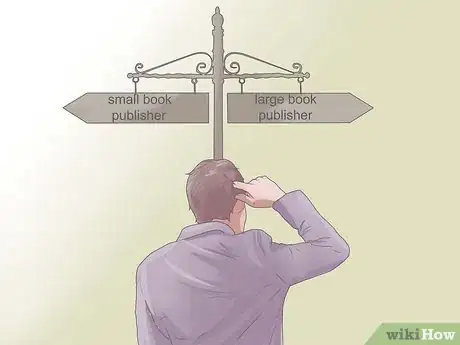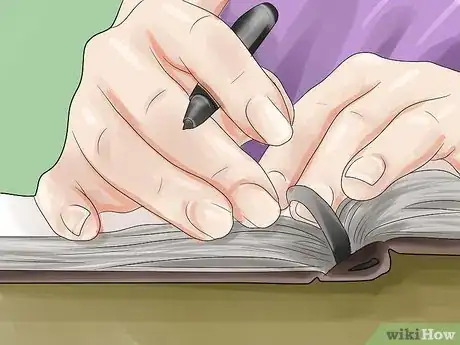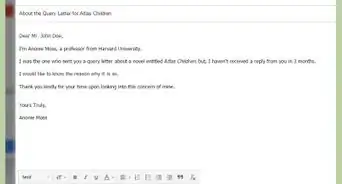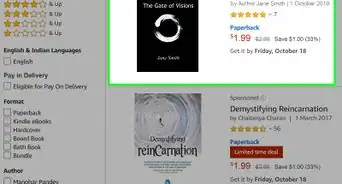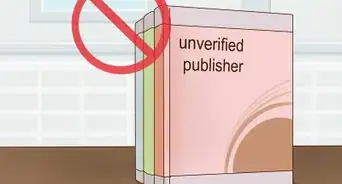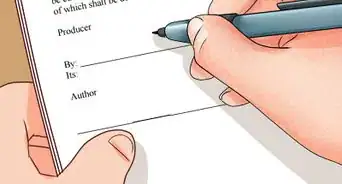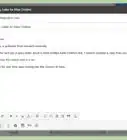This article was co-authored by Janet Peischel. Janet Peischel is a Writer and Digital Media Expert and the Owner of Top of Mind Marketing. With more than 15 years of consulting experience, she develops content strategies and builds online brands for her clients. Prior to consulting, Janet spent over 15 years in the marketing industry, in positions such as the Vice President of Marketing Communications for the Bank of America. Janet holds a BA and MA from the University of Washington.
There are 9 references cited in this article, which can be found at the bottom of the page.
wikiHow marks an article as reader-approved once it receives enough positive feedback. In this case, 100% of readers who voted found the article helpful, earning it our reader-approved status.
This article has been viewed 154,355 times.
You've finally wrapped up the article you've been working so hard on and now it's ready for publication. But first, you have to submit it. Submitting your first article is an exciting process. There are different procedures depending on whether you are writing an academic article or a personal essay. Regardless of what type of work you produce, there are several steps you can take to make the process a little easier.
Steps
Choosing the Right Publication
-
1Submit a piece to a literary journal. There are many different types of publications. Where you submit your piece will depend on what type of article you have written. If you write fiction, you will want to submit your article to a literary journal.
- Start by doing your research. Use the internet to search for literary journals.
- Look at the website for each journal. Browse some of the past issues. This will give you a good idea of what types of articles that particular journal publishes.
- Head to the library. Ask the reference librarian to help you find a complete list of literary journals. Make sure that the journal you are interested in accepts unsolicited submissions.
-
2Find an appropriate academic journal. If you are a scholar, your article will usually be best placed in an academic journal. These publications are typically categorized very specifically by topic. They also generally require a very rigorous review process.[1]
- Make sure that your research fits the scope of the journal. For example, if you are a scholar of European history, do not submit your article to a journal that focuses solely on East Asian history.
- Verify that the publication is peer-reviewed. This means that other scholars will review your work.
- Be aware that it may take a while to receive an answer from the editor. The review process for academic journals can often take several months.
Advertisement -
3Decide where to submit a personal essay. A personal essay is non-fiction. It can be a story about your own experiences. The most effective personal essays are ones that many different types of people can relate to.[2]
- There are several different types of publications that publish personal essays. Make sure to choose one who's readers might be interested in your story.
- Many newspapers publish personal essays in the magazine section of the paper. Major papers such as The Boston Globe and The New York Times publish these types of pieces.
- You might also consider submitting your essay to an online magazine. Popular publications such as Slate and Salon offer their readers essays on a wide variety of topics.
- Send a pitch to the appropriate editor. For example, if you want to write an essay about politics, send an e-mail to the editor at Slate who works on political topics.[3]
-
4Propose an op-ed article. An op-ed is an opinion piece. It differs from a personal essay, which might just be telling a story. With an op-ed, you are taking a definitive stance on an issue and trying to persuade readers that you are correct.[4]
- Op-ed pieces are typically fairly brief. A common op-ed is usually between 400-1200 words.
- Most newspapers accept op-ed pieces on a variety of topics. You can find specific guidelines on the newspaper's website.
- Make your piece topical. If your op-ed is timely, it will have a better chance of being published. For example, a piece about veterans services might be appropriate to submit around Memorial Day.
-
5Research the publication. You want to make sure that your work appears in a reputable publication. For example, you don't want to publish in a journal or magazine that has a reputation for publishing sub-par material. Do some research before submitting your pitch or article.[5]
- Try to avoid predatory publications. These are journals who charge exorbitant author fees and will publish almost anything.
- Academics often feel pressure to publish regularly. It's important not to be lured by promises of publication in exchange for high fees. These publications typically do not have rigorous standards.
- Fiction writers can also find magazines that will publish in exchange for money. These publications are typically not highly regarded. If you are asked for money before your article appears, consider whether this is the right venue for your work.
- Some publications that charge author fees are reputable. If you feel a fee is appropriate, make sure that you pay it using the specified method.
Preparing Your Article
-
1Say something original. Your article should offer some new information or a unique perspective. Editors are looking for a fresh take on a topic that will excite or interest their readers. This is true for fiction and non-fiction.[6]
- Make it clear why your article is original. For example, if you are writing an academic article, you can emphasize the new sources you've utilized.
- In your introduction, highlight the unique aspects of your research. For example, you might say, "Based on newly declassified sources,..."
- If you are submitting a personal essay, explain your point of view. Make it clear to the editor and the readers why your take on the topic is interesting. You could say, "My experience as a first time mother was different than most because..."
-
2Edit extensively. No matter what type of article you are writing, it is important that you edit your piece very carefully. Editors will not be impressed if you submit an article that is full of errors. You also need to make sure that your article flows coherently.[7]
- After you produce a first draft, go back and edit for content. Make sure that the points you are trying to make are clear.
- Pay attention to organization. Do you make it clear at the beginning what the point of your article is? Is your conclusion thorough? Would reorganization help?
- Edit for grammatical/stylistic errors. Make sure that your spell check is set to check style as well as just grammar. Spend time carefully reading each sentence to make sure your piece is error free.
-
3Get some feedback. Sometimes it can be difficult to be objective about your own writing. Or maybe you are just feeling uncertain about your content and you could just use some advice. No matter what you are working on, it can be really useful to get a second opinion.[8]
- Ask a friend to read your work. Try saying, "Do you have some time this week to read an article that I'm working on?"
- Accept constructive criticism. Don't take it personally if your friend offers you some tips for improvement.
- Choose a friend whose opinion you respect. This will make it easier to accept and utilize their feedback.
-
4Follow the submission guidelines. During the editing process, it is important to make sure that you understand all of the submission guidelines. The guidelines should be clearly stated on the publication websites. Most journals, magazines, and papers will tell you the precise qualifications for an article.[9]
- Pay close attention to the guidelines. They are not merely suggestions. Many publications will not read your work if it does not fit the parameters of the guidelines.
- Adhere to the length requirements. Most journals will give you a word count for minimum and maximum length.
- Format your citations as specified. Some publications prefer endnotes, some require footnotes. Make sure you use whichever system the journal uses.
Submitting Your Article
-
1Deliver your article. Many times, you will submit a pitch or abstract before you actually submit an article. Check the submission guidelines to see if that is the process for the magazine or journal you are interested in. The editor will often approve your pitch and tell you to write and submit the article.[10]
- If your pitch is accepted, the editor will often request the article within a specific time frame. Make sure that you submit your article on time.
- If you are an academic, your first submission may receive what is called a "revise and resubmit". This means that your article shows promise, but needs some revisions.
- Submit your revised article in a timely manner. Ask the editor for a clear timeline, and then deliver the article by that deadline.
-
2Keep thorough records. Getting an article accepted for publication can be a lengthy process. You will likely have to submit your piece to more than one publication. Make sure to keep track of where you send your work.
- Write down where you send which article. If you are working on multiple pieces at once, it is helpful to keep track of where you have sent various pieces.
- Make note of the date you send each submission. That way, you can have an idea of when you can expect to receive a response.
- Maintain records of any communication with the publication. For example, if the editor e-mails you with suggestions for future pieces, you will want to retain that organization.
-
3Handle a rejection. As a writer, you have to deal with rejection. Finding an outlet for publication can be difficult, and often takes several attempts. Make sure that you are prepared to handle a "no".
- Do not take it personally. Understand that editors receive more submissions than can be published. Just because your article was not the best fit for that journal does not mean that your work is not good.
- Move on. Be ready to send the article on to the next publication on your list. And you should definitely have a list of publications that you would like to submit your work to.
- Do not respond. There is no need to follow up on a rejection note. While it might be tempting to express your frustrations, it is better to accept it gracefully and move on.
-
4Acknowledge an acceptance. If you get an acceptance notification, congratulations! You can immediately reach out to the editor and acknowledge that you have received their notification. E-mail is usually the preferred method of communication.
- Provide the editor with any information that is requested. You may be asked for contact info., for example.
- If your article is being considered at another publication, you should immediately withdraw it from consideration. Send a notification explaining that your article will be published elsewhere.
- Celebrate. Having a piece of writing accepted for publication is a great accomplishment. Congratulate yourself and share your good news with friends and family.
Expert Q&A
-
QuestionHow can I submit an article to the newspaper?
 Janet PeischelJanet Peischel is a Writer and Digital Media Expert and the Owner of Top of Mind Marketing. With more than 15 years of consulting experience, she develops content strategies and builds online brands for her clients. Prior to consulting, Janet spent over 15 years in the marketing industry, in positions such as the Vice President of Marketing Communications for the Bank of America. Janet holds a BA and MA from the University of Washington.
Janet PeischelJanet Peischel is a Writer and Digital Media Expert and the Owner of Top of Mind Marketing. With more than 15 years of consulting experience, she develops content strategies and builds online brands for her clients. Prior to consulting, Janet spent over 15 years in the marketing industry, in positions such as the Vice President of Marketing Communications for the Bank of America. Janet holds a BA and MA from the University of Washington.
Digital Media Expert Reach out to the editor and pitch the idea that you have for your article to see if it's something they want to run.
Reach out to the editor and pitch the idea that you have for your article to see if it's something they want to run. -
QuestionHow do I format an email for submitting an article for publication in a newspaper
 Community AnswerIf you know the editor's name, address them personally. Otherwise, a generic salutation is fine. Try saying something like, "Dear Name, My name is Blank Blank. Attached please find my submission, "Title of Your Article". Please let me know if I can provide you with any further information. Thank you for your time. Sincerely, Blank Blank
Community AnswerIf you know the editor's name, address them personally. Otherwise, a generic salutation is fine. Try saying something like, "Dear Name, My name is Blank Blank. Attached please find my submission, "Title of Your Article". Please let me know if I can provide you with any further information. Thank you for your time. Sincerely, Blank Blank
References
- ↑ http://www.journals.uchicago.edu/
- ↑ http://thewritelife.com/19-websites-magazines-want-publish-personal-essays/
- ↑ Janet Peischel. Digital Media Expert. Expert Interview. 30 March 2021.
- ↑ http://www.nytimes.com/content/help/site/editorial/op-ed/op-ed.html
- ↑ http://www.scidev.net/global/publishing/practical-guide/target-journal-right-research-communicate-publish.html
- ↑ http://www.studentpulse.com/blog/posts/51/5-tips-for-publishing-your-first-academic-article/
- ↑ http://www.studentpulse.com/blog/posts/51/5-tips-for-publishing-your-first-academic-article/
- ↑ http://writingcenter.unc.edu/handouts/reading-aloud/
- ↑ http://www.nursingworld.org/MainMenuCategories/ANAMarketplace/ANAPeriodicals/OJIN/AuthorInformation


